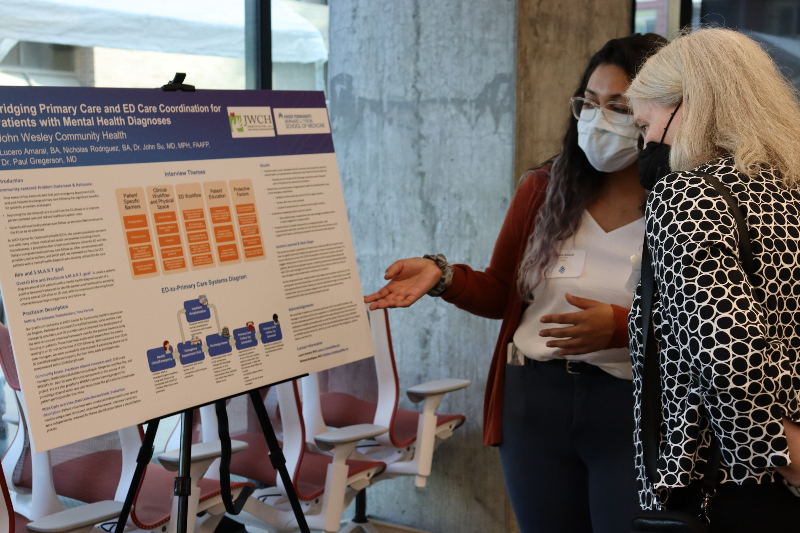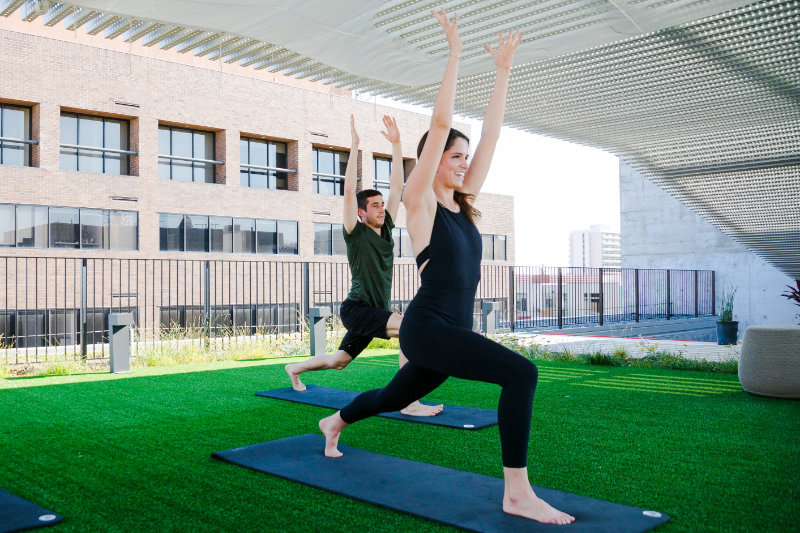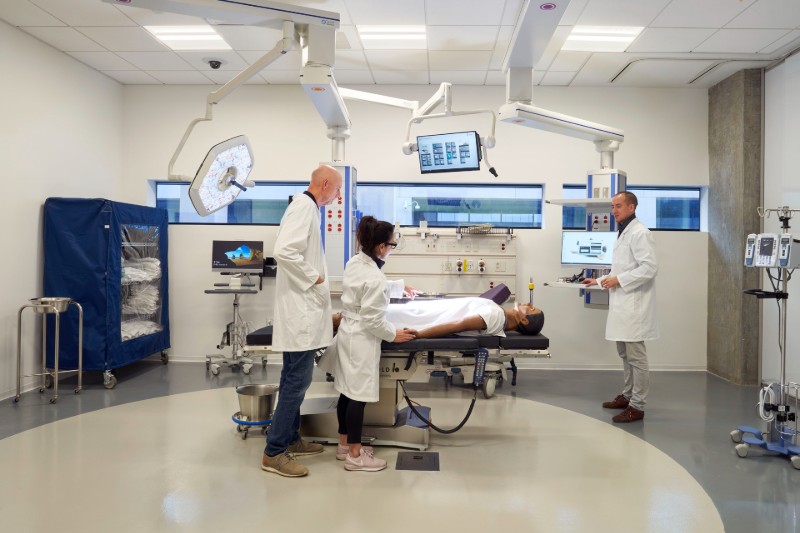First class at Kaiser Permanente Bernard J. Tyson School of Medicine completes 2-year course to understand community health needs.
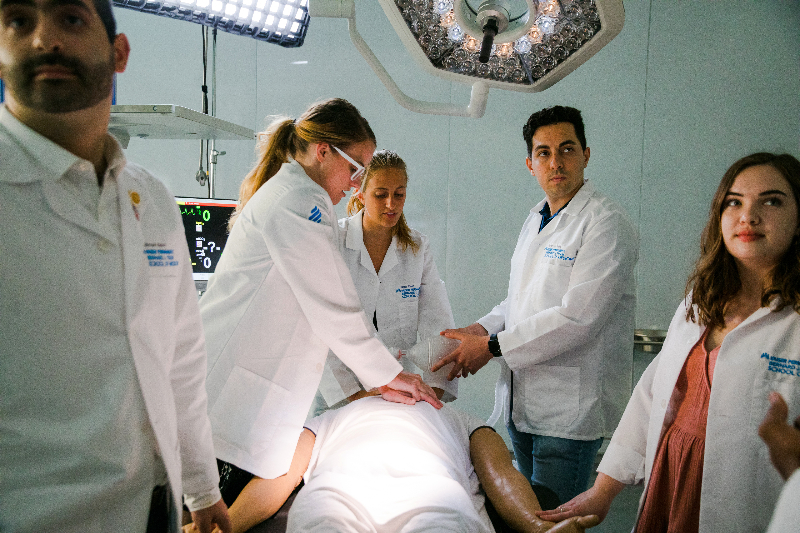
Students perform a procedure on a high-fidelity mannequin in the Kaiser Permanente Bernard J. Tyson School of Medicine Simulation Center.
Innovative technology simulates real-world scenarios for medical students
Kaiser Permanente medical school’s simulation center provides hands-on experience
At the Kaiser Permanente Bernard J. Tyson School of Medicine, an 8,800-square-foot Simulation Center provides a highly realistic environment for students to experience a variety of clinical scenarios – from routine exams to serious diagnoses to critical care events – through a combination of technological devices and specially trained actors standing in for patients.
The high-tech classroom, known informally as the “Sim Center,” enables medical students at the Pasadena, California, school to receive training in real-world doctoring situations so they can consolidate their knowledge and hone decision-making skills. It’s also a safe space that allows students to gain valuable experiences that puts them ahead of the curve when it comes time to treat actual patients.
“There are lots of benefits of simulation, and one certainly is psychological safety,” says Candace Pau, MD, the medical school’s faculty director of Simulation. “That’s good for student confidence and it’s also good for patient safety. Simulation helps our students practice all sorts of skills, from communicating with patients, to the psychomotor skills of complex procedures like a spinal tap, to the intricate teamwork necessary for critical care situations.
“In simulation,” she adds, “students have the freedom to make mistakes and then grow from them.”
Simulated clues to solve clinical mysteries
The simulated exam and hospital rooms are equipped with cameras and video systems so students can record procedures and review their work under the guidance of a faculty member. During emergency care scenarios, an instructor in an adjacent control room monitors the situation and, when needed, provides guidance over an intercom. A simulation technologist operates a realistic-looking mannequin, controlling its respiratory system, heart rate, eye movements, and other vitals that the student doctors must respond to in the moment.
In simulation, students have the freedom to make mistakes and then grow from them.
– Candace Pau, MD, faculty director of Simulation
“This is all designed to provide clues, because this is what health care providers face in their daily work – mysteries to be solved,” says Sylvia Merino, director of Simulation and Technology. She says the hands-on experience goes beyond the classroom and reading cases or answering multiple choice questions on a test. “A completely different part of your brain is being used,” Merino says. “In simulation, you’re standing here, being put on the spot, and forced to put the things you’ve learned in the classroom into practice.”
The mannequins, which cost from about $70,000 to $150,000 apiece, range from newborn to adult, including a pregnant mannequin that can simulate a live birth. The mannequins come in a variety of skin tones and have interchangeable genitalia to represent a diverse patient population.
Related story: “A modern approach to teaching anatomy”
Sophisticated mannequins, standardized patients mirror patient conditions
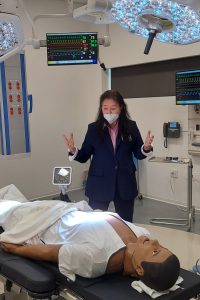
The mannequins are so sophisticated that they can simulate internal conditions such as wheezing, secreting saliva, a pulse, or a heart murmur. They can also exhibit hives, contusions, sores, or other conditions requiring treatment. The simulations help students learn to make clinical decisions under the pressure of fast-moving, urgent-care situations. It also helps them practice teamwork and communication.
Another important component of the Sim Center is student interaction with standardized patients, highly skilled professionals who are trained to portray a specific patient case. Before seeing a student doctor, they study a detailed scenario outlining the “symptoms” they are experiencing, their emotional state, and other criteria that will influence the nature of the exchange and put the student’s clinical knowledge and communications skills training to the test.
“As I was speaking with a patient, they produced a tear,” says medical student Michael Okene. “And as I’m taking tissues and giving it to them, I’m just thinking in my mind, ‘this is absolutely wild.’ For someone to be able to produce this on command, it really speaks to the experience and how well simulated it is.”
Standardized patients also “work to foster expression of empathy – they let the student know how they made them feel,” says Carla Lupi, MD, associate dean for Assessment and Evaluation at the school. This training also emphasizes advanced communication skills such as delivering difficult news and dealing with uncertainty, she adds.
The center’s Inpatient Simulation Suite has 4 hospital rooms where critical care scenarios are practiced. The space is designed to replicate the hospital facilities at a typical Kaiser Permanente medical center. An outpatient suite with 10 clinic rooms mirrors a typical Kaiser Permanente medical offices.
Evolving technology and curriculum
As the importance of simulation in medical education grows, the role of the Kaiser Permanente medical school’s Sim Center will continue to evolve the school’s curriculum. The facility plays a key role in preparing students for their longitudinal integrated clerkships, which begin early in their first year and pair them with a physician-preceptor in a Kaiser Permanente medical facility. Next year, when the Class of 2024 becomes the school’s first cohort of fourth-year students, the Sim Center will play a vital role in preparing students for their transition to residency.
Dr. Pau says she expects the center’s technology to evolve, and she predicts more use of virtual patients and digital interactions as software and other tools become more advanced. “It’s on the technological frontier to really do immersive virtual simulation,” she says.
This is all designed to provide clues, because this is what health care providers face in their daily work – mysteries to be solved.
– Sylvia Merino, director of Simulation and Technology
For current students, the Simulation Center is valued as a high-tech training space enabling them both to apply classroom learnings in a real-life context and to focus on applying the techniques of patient care in a realistic clinical space. They also credit the center’s faculty and staff with creating a supportive environment where some of the stresses of medical school can be overcome.
“They make it a place where I feel like I can come in and make mistakes and really embody the fact that I am playing a doctor and learning these skills at the same time, and it feels like a safe space to do that,” says medical student Kelly Shriver. “And that is a real gift of this program.”
